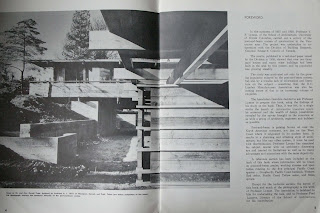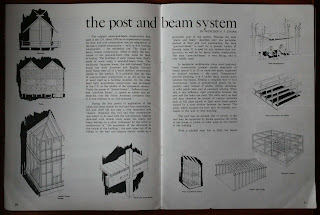 In the late 1950's, the British Columbia Lumber Manufacturers Association published a booklet entitled "post and beam". Geared towards builders and industry, the piece is a showcase - and how-to manual - for the simple building style using various examples of timber framing drawn from local designs.
In the late 1950's, the British Columbia Lumber Manufacturers Association published a booklet entitled "post and beam". Geared towards builders and industry, the piece is a showcase - and how-to manual - for the simple building style using various examples of timber framing drawn from local designs.
The work of Thompson, Berwick & Pratt in particular is covered - no surprise given the number of projects they were working on at the time. RJ Thom's Copp Residence is given a gatefold spread and photos from the Forest Products Labaratory at UBC and Inlet Acres Shopping Centre in Port Moody are also included. Other architects' whose work appears: Duncan McNabb (Westcot Elementary, Reid Residence); and John Porter, whose Nemetz Residence at UBC features prominently in colour on the front cover.


As noted in the foreward, the booklet was organized by V.F. Lyman. A professor at the School of Architecture at UBC, Lyman carried out a survey of the Post and Beam style from 1957-58 at the request of the BC Lumber Manufacturers Association and was then charged with organizing the materials (research, photos, essays) into published form. Lyman's essay details the history of the building style as well as its more prosaic aspects, under sub-heads such as 'Moisture Content & Spiking', 'Joints and Connections' and 'Advantages of Post & Beam'.
Fred Lasserre, also a Professor and the Director of the School of Architecture at UBC, contributed an essay titled "An Introduction to Wood" which is based largely on a lecture series he gave in Great Britain in April, 1956. It is a more general overview of the benefits and uses of a building material so widely available at the time.
Also included is a short technical section near the end, in an effort to inform builders of the specifications of Post & Beam-style building, covering areas like 'Recommended Spans For Decking', 'Stresses For Posts and Beams' and 'Description of Grades'.
The booklet documents an era when Post & Beam building was on its way to a brief ascendency, largely due to the simplicity of the method and the availability of materials. Indeed, builders on the West Coast did employ it for both high-design architecture as well as developer built houses. Propelled by a wood industry that was actively promoting its products - as evidenced by this very document - it was coming at the heyday of material extraction in the forest industry. The local modernist architects of the day took advantage of these circumstances to create buildings that were of their time and place - a time that would eventually morph into one whose designs became more involved and complex and later post-modern.
From the preface (uncredited, but presumably written by V.F. Lyman):
"As nearly as any construction can be, the post-and-beam system is directly evolved from the tree. In the historical Tudor houses of England, antecedents of the contemporary post-and-beam building, great time-toughened beams still call to mind the noble Oaks of a bygone age. To this overt link with the living tree much of their charm is owed.
Adherence to the same principle evident in the Tudor period is to be found in the finest architecture throughout history. The materials employed have been accepted for what they are, used with logic and allowed honest expression in the structure. The immorality of simulation has been instinctively understood from the beginning.
Contemporary post-and-beam at its best continues this tradition and even reinforces it, for the system is well able to fulfill the principles of modern design. It is not surprising that so much of its development took place in the shadow of the Pacific Coast forests, nor that its influence is being increasingly felt throughout North America and abroad.
Pacific Coast timbers perfectly match the technical and aesthetic requirements of a building of this kind. Used with skill and imagination, they have the power to recapture far from their source the dignity, beauty and majesty of the Coastal forest stand."
All photos: V.F. Lyman
